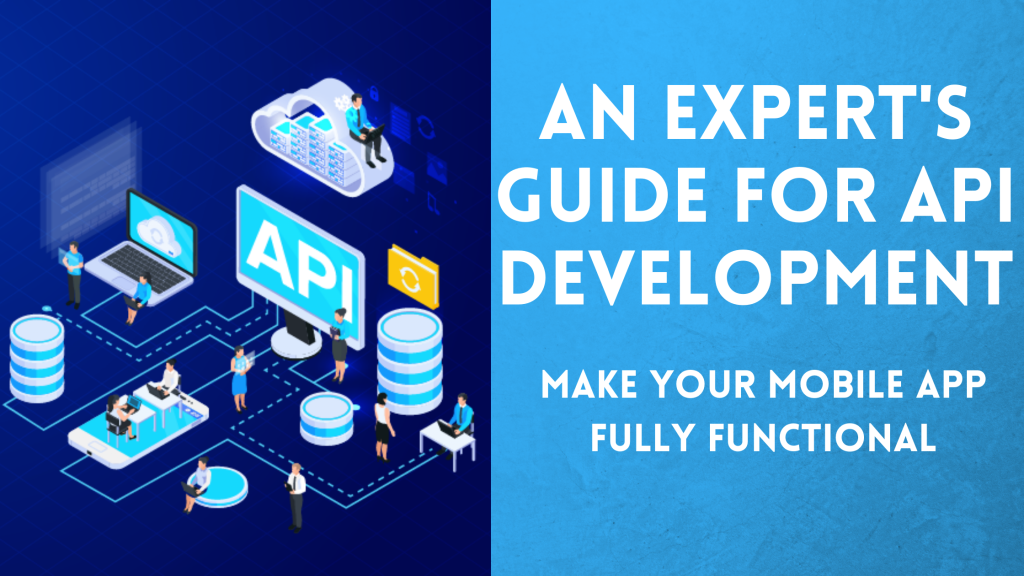Have you ever noticed when you hit on the ‘Connect Facebook’ button in Candy Crush mobile game, how quickly you share your game score on Facebook with your friends?
Or when you book a ride on an app, how efficiently it uses Google Maps for navigation?
Who is the hidden hero that makes everything smooth behind your mobile app?
It is API.
APIs are the tools that connect today’s digital ecosystems. Companies, who understand the importance of API, can reduce their app development costs, improve efficiency and make their app more functional.
This blog will guide you on how to use APIs so that you can make your mobile app fully functional and more powerful.
Table of Contents
ToggleWhat is API?
Application Programming Interface (API) is a fundamental building block of functions and procedures that enables a mobile application to access data and features of other applications.
In simple words, API is a software-to-software interface that borrows functionality and features from one application to another.
For example, cab booking apps use Google Maps for navigation or other location-based utility, instead of creating their own Map.
API is an unsung hero for developers as well as companies. When app developers have to write a new program, they don’t have to start from scratch to build a separate application. Instead of this, they can use other application’s functionality in their existing app.
Examples of API
- Weather Snippets
- Log-in via social media accounts such as Facebook Login API
- Pay with mobile payments apps
- Ticket booking
- Google Maps APIs
- Spotify Web APIs
- HubSpot APIs
- Twitter APIs
For what purposes APIs are used?
APIs are used for enabling various functionalities into the app. If you want to embed Instagram photos on your eCommerce mobile app, there is an API for that.
If you want to provide a quick access to thousands of hotels on your travel blog, there is an API for that. If you want to integrate a Yoda translator on your Star Wars fan fiction website, yes, there is an API for it.
So, for any unique functionality, there is an API available for your mobile app. That is why enterprises use APIs in mobile app development.
Android app development companies in India offer dedicated API development services for enterprises and businesses. According to a report, the API development market is estimated to grow from $1.2B from $5.1B by 2023 globally.
Types of APIs
1. Private APIs
Private APIs are only meant for the workforce to enhance productivity and transparency. In short, developers who work for the company can use these APIs, not third-party developers.
These private APIs are not documented in a publicly released SDK; they are mostly hidden from the public. But sometimes many enterprises even go public with their private APIs.
2. Partner APIs
Partner APIs are shared externally only with those who have a business relationship or partner with the API provider company. The idea of partner APIs is based on making profits on a mutual partner system.
Think of the traffic app Waze which uses APIs to exchange data with municipalities and other partners for a wide range of information on road closures, accidents, construction delays, potholes, garbage trucks, etc.
3. Open APIs
Open APIs or commonly known as public APIs which are available for external usage. While some public APIs are free, others need a paid subscription to use.
These Open API providers allow APIs sharing beyond organizational boundaries to make companies learn lessons about authentication, documentation, support, and schemes that increase the adoption of their APIs.
This helps in boosting the brand image of the API providers and encouraging third parties to build apps, add-ons, or integrate APIs that not only make their product or mobile app more valuable but also enhance the demand for their APIs.
4. Composite APIs
Composite APIs enable to bundle calls or requests to get one unified response from multiple servers. If you need data from different applications, you will have to use a composite API.
You can utilize this type of API to set up an automatic chain of calls and responses without your intervention.
Important API Terminology that you should know
1. API Key- An API key is a unique identifier or code passed in the application to authenticate the developer or user.
2. Endpoint- When an API communicates with other systems, one end of the communication channel is known as endpoint.
3. JSON- JavaScript Object Notion (JSON) is a data format used for APIs to exchange data on the web. This interchange of data can be implemented between two applications or a server and a web application.
4. GET- It is a technique that is used to request data from a server at a particular resource.
5. POST- It is a method that is used to send data to an API server to update or create a resource.
6. Latency- The time consumed by an API for processing a request and response is known as latency.
7. Rate-Limiting- This is a process of controlling the rate of incoming and outgoing traffic. It is also defined as the number of requests a user makes to API every time
8. API Throttling- It is the process of controlling the usage of APIs by users for a specific duration.
That’s great! you have understood some important points. This will help you in using various API tools for your Android or iOS application development. For your help, here we have mentioned the popular API development tools:
Tools for API Development
1. Apigee- This is Google’s API development management tool. It helps developers to integrate apps, update existing apps, and enable data transfer between services and mobile apps.
2. Dredd- It is an HTTP API testing framework that takes an API description document, builds expectations based on requests and responses documented in the documented responses, validate the results, check whether API responses match the documented responses, etc.
3. API Spec Converter- This is a tool that allows developers to convert between different API spec formats.
4. APIMatic- It is a developer platform for web APIs which is used for generating SDKs for their APIs and keeping them in sync with the API updates.
5. APIMatic also allows developers in converting API descriptions into various formats such as Swagger, RAML, WADL, OAI format, API Blueprint, IO Docs, Postman Collections, HAR 1.4, and more.
6. Sandbox- It gives an easy and immediate mock RESTful API from API definitions. Sandbox reduces the cost and risk associated with calling third party API during testing.
7. Postman- This is an interactive and automatic tool that enables developers to run, test, document, and measure the performance of their API.
8. SoapUI- It is an open-source testing API too that operates on cross platforms and automates both functional and non-functional tests. SoapUI is mainly used for implementing compliance, regression, security, and load tests for Web APIs.
9. Swagger- This is an open-source framework that is used for API development. Many top technology giants such as Apigee, GettyImages, Microsoft, and PayPal use this API tool.
10. JMeter- It is open-source software that is used for testing the performance of a RESTful API.
Essential features in API Development
API development depends on the type of features you want to add. Make sure to include these essential features in your APIs that can improve your app development process:
- Authentication and Authorization
Authentication means validating the right identity. While creating an API, you should decide whether a verified user is allowed or not to perform a certain action on a particular source. For example, a user can get a resource but not allowed to develop a resource.
OAuth, OAuth2 and JWT are some of the commonly used specifications to manage authentication and authorization process.
- Query, Filter, Sorting & Pagination
With time your app database will grow. Once that happens, your will notice that some resources are taking longer than usual time to retrieve. By sorting, you can ensure that data is retrieved by the user one by one as per need, modification, and the condition applied.
Paging is the method of determining how much data should be displayed and at what frequency. These features make your API work better with good response time and high-level security.
- Cache
Developing a Cache strategy allows a user to retrieve resources at a paid speed. Once your data is ready to be consumed in the in-memory database, the cost of your requests will be decreased. You can use tools like Redis and Memcached for this specific purpose.
- Wrappers
API wrappers are language specific packages or containers which integrate sets of API calls into user-friendly functions.
Now you are excited and ready to use APIs in your mobile app. Let us tell you how to use APIs in app development that makes your mobile app fully functional.
How to use APIs in mobile app development:
Step 1: Choose an API
At first, you need to find an API that is perfect for your mobile app as per your business goals. You might be already familiar with popular APIs like Facebook and Twitter API. Or you can start with a free API before you invest in paid APIs.
You can search with right keywords on search engine for API marketplaces. Once you choose an API, time to look through the API documentation.
Step 2: Review the API Documentation
API documentation is basically an instruction manual about how to use and integrate an API to your mobile application. In this documentation, you can check whether you need an API key or not. API documentation usually contains examples and tutorials to help developers for API integration.
However, many developers don’t read this documentation seriously; as a result, they fail to fully utilize the benefits of API.
Step 3: Write a Request
The next step is to write your request. You can use Postman or another HTTP client online which has tools to help you structure your requests. But make sure you understand and get some information from API documentation.
You can also use DIY route and create a URL by tweaking the examples in the existing API documentation to get your desired output. It may sound different, but you don’t have to be a developer to do it.
The Final Words
It’s done. You can now successfully implement your APIs by following these steps. Keep it simple and make sure users find it easy to use your API functions. If your mobile app has a goal to cater to a large number of people, implementing right APIs matters a lot for the success of your business.
And eSearch Logix here stands out as a premium mobile app development company in India that provides modern API development services.
No matter what type of feature or functionality you want to integrate in your app, our developers are highly expert in adding the right APIs to your mobile app.
Discuss your idea and get a free consultation on your next mobile app project.








